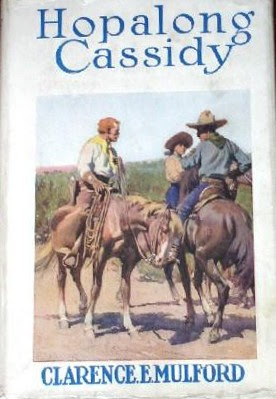Book Review: Hopalong Cassidy by Clarence E. Mulford
There’s trouble brewing in Texas between the cowboys of the Bar-20 Ranch, and those of the H2. Meeker, owner of the H2, is down from Montana, where the rule was open range, and he’s not used to the strict water rights situation in his new territory. (It doesn’t help that the syndicate that sold the land to him didn’t bother to mention the issue.) Meeker’s determined to use the easily accessible water just north of his range, which belongs to the Bar-20. And in this arid land, that’s not enough water for both spreads.

Foreman Buck Peters of the Bar-20 isn’t too concerned about the H2 riders getting the better of his, as they’re a superior lot of cowpokes, especially Bill “Hopalong” Cassidy. Bill might have lost part of a leg to an assassination attempt years ago, giving him his distinctive gait, but he’s a top hand at cattle herding, shooting, and figuring out the best thing to do. No, push comes to shove, the Bar-20 will come out on top of any range war.
More worrisome is that during such a war, rustlers will have a free hand to steal cattle while everyone is distracted. It’d be best if this matter could be settled without bloodshed, but Meeker’s bullheaded and not listening to anyone sensible, like his pretty daughter Mary (who has met Hopalong and is getting on well with him.)
What none of them know is that the H2’s bronc buster Antonio is actually the leader of the local rustling gang, and is determined to set off the war one way or the other so he and his cohorts can profit.
This 1910 novel is the third book in the Hopalong Cassidy series, which started with Bar-20 in 1906 (a fix-up of several stories starting publication in 1904.) It’s a good standalone, with the exception of never explaining his nickname or mentioning his odd walk. (Though it is mentioned that cowboys tended to be poor walkers, having spent most of their time in the saddle.)
Good: There’s plenty of exciting Western action and it’s easy to see the seeds of a good B-movie in here. The long last third of the book is the siege and infiltration of a rustlers’ hideout high on a mesa. It’s tense and has several twists. Not a lot of time is spent on distractions like the love story.
There’s several memorable characters, my favorite of which is Salem, the H2 cook, who’s a former sailor and speaks in a near-impenetrable nautical dialect. People other than Hopalong get to do their own impressive moments.
Less good: While the characters never comment on national origins, it’s notable that every man in the book with a Spanish name works for the rustlers. It’s…odd that the Bar-20, which is within a couple days’ ride of the Rio Grande, has no vaqueros.
The romance is very much “there’s only one female character, so of course she’s going to get with the hero of the story.”
I’m also kind of disturbed that the author’s idea of pure masculine friendship involves everyone involved constantly insulting and threatening each other. Which is exactly how they treat their enemies too. (Which brings up the notion that Antonio might be the villain simply because he’s too thin-skinned to realize that the other H2 workers were attempting to be friendly when they constantly belittled and abused him.)
Hopalong’s pretty rough around the edges in this book, smoking a pipe, drinking (but not to excess), cussing, and quick to think the worst of strangers. He was cleaned up considerable for the movies.
Tor reprinted a few of the Hopalong Cassidy books in the 1990s, but many are in the public domain and can be legally downloaded.
Recommended to old-style Western fans.
Here’s a trailer for the 1935 movie version:

